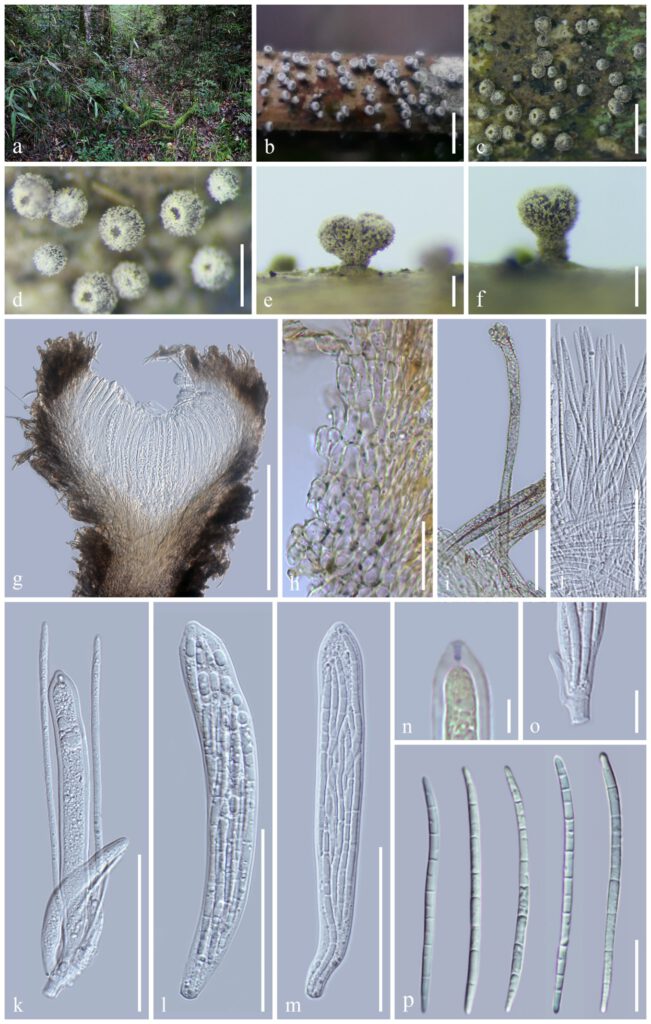Erioscyphella griseibambusicola H.L. Su, Q. Zhao & K.D. Hyde, sp. nov. Fig. 1
Diagnosis – Characterized by minute, cupulate to globose apothecia, abundant, long, brown hairs with resinous materials on the apex.
MycoBank number: MB; Index Fungorum number: IF; Facesoffungi number: FoF 12851;
Etymology – “grisei” means grey, “bambusicola” means bamboo. The species has grey apothecia occurring on bamboo culm.
Saprobic on dead bamboo culm. Sexual morph: Apothecia scattered to partly gregarious, superficial, 0.2−0.4 mm in diam., 0.3−0.5 mm high when dry, cupulate when fresh, globose when dry, shortly stipitate, leathery, externally covered with abundant, long and greyish yellow hairs. Disc concave, surface slightly rough, white to grey. Margin involute obviously, white to grey, clothed with abundant and white to brown hairs. Receptacle cupulate to globose, brown, clothed with abundant, long and greyish yellow hairs entirely. Stipe 0.1−0.2 mm in diam. (including hairs), 0.1−0.2 mm long when dry, cylindric, most solitary, some gregarious with the common base, dark brown, clothed with abundant, long and white to brown hairs. Hymenium 115–140 µm (x̄ = 130 µm, n = 10), concave, surface slightly rough, white to grey. Medullary excipulum 55–100 µm (x̄ = 80 µm, n = 15) thick, hyaline, colorless, thin-walled, smooth, hyaline hyphae of textura intricate, 2.0–4.5 µm (x̄ = 2.8 µm, n = 50) in diameter. Ectal excipulum 15–35 µm (x̄ = 23 µm, n = 22) thick, thick-walled, smooth, brownish cells of textura porrecta, 5.5–18.5 × 3.0–6.5 µm (x̄ = 10.5 × 4.3 µm, n = 51). Hairs 60−160 × 2.5−5.0 µm (x̄ = 96 × 3.9 µm, n = 47), cylindric, straight to slightly curved, multiseptate, light brown to dark brown, thick-walled, covered with colorless granules totally, obtuse apex crowned with light brown amorphous materials, not dissolved with CB/LA. Paraphyses 100–150 × 2.0–3.0 µm (x̄ = 123 × 2.5 µm, n = 50), longer than asci, filiform, straight, septate on the base, hyaline, colorless, thin-walled, slightly rough, with slightly acute apex. Asci (100–)95–120 ×10–15 µm (x̄ = 107 × 12 µm, n = 47), unitunicate, 8-spored, clavate, straight to slightly curved, inoperculate, hyaline, wall apically thickened, laterally relatively thin, slightly rough, with a apical, amyloid pore and slightly tapered ends, croziers absent at the basal septa, blue in MLZ or IKI with and without 3% KOH pretreatment. Ascospores (90/14/2) (57.0–)59.0–76.0(–81.5) × (2.0–)2.5–4.0 µm, (x̄ = 67.0 × 2.9 µm, Q =16.5–31.7, Q = 23.43±3.45), fascicled, filiform, 7–8-septate, thin-walled, hyaline, and slightly smooth in mature, rough with some oil guttules in immature, with obtuse acute end. Asexual morph: Unknown.
Known distribution – an evergreen broadleaf forest in the Ailao Mountain, Yunnan, China.
Material examined – China, Yunnan, Ailaoshan, on the fallen bamboo culm, 29 August 2021, H.L. Su, SHL70 (HKAS ***, holotype); ibidem, on the fallen bamboo culm, 28 August 2021, H.L. Su, SHL44 (HKAS ***, paratype).
Notes – The new species bears similarity with Erioscyphella papillaris and E. otanii in having minute apothecia and white to light yellow hymenium, while the latter two reference species are phylogenetically distant from the former. Besides, the three species are morphologically different. Erioscyphella griseibambusicola has grey to greyish yellow apothecia, light brown to dark brown hairs with light brown amorphous materials, and the apex crowned with light brown amorphous materials. However, E. papillaris has white to lemon yellow apothecia, hyaline hairs with hyaline amorphous materials, lacking any crystals or resinous matters. Furthermore, E. griseibambusicola has longer hairs, asci, ascospores, and paraphyses than those of E. papillaris. Erioscyphella otanii has pure white to pale yellow apothecia, hyaline, shorter hairs, asci, ascospores, and paraphyses than those of E. griseibambusicola (Table 2). Furthermore, E. griseibambusicola is on the dead bamboo culm, while the other two species are on the fallen leaf of bamboo.
The phylogenetic analyses based on the combined LSU, ITS, mtSSU and RPB2 dataset showed that E. griseibambusicola was sister to a clade containing seven species, E. hainanensis, E. sinensis, E. euterpes, E. lushanensis, E. paralushanensis and E. boninensis. When comparing Erioscyphella griseibambusicola with the seven species, our new species differs substantially from the seven species (Table 2), so we introduce our specimens as one new species.

Fig. 1 – Erioscyphella griseibambusicola (HKAS***, holotype) a Habitat. b Fresh apothecia on host surface. c–f Dried apothecia. g Vertical section of an apothecium. h Section of the excipulum. i Hairs. j Paraphyses. k An immature ascus and paraphyses. l–m Asci. n Apex of an ascus. o Base of an ascus. p Ascospores. Scale bars: b = 2 mm, c = 1 mm, d = 500 µm, e–g = 200 µm, h–i = 20 µm, j–m = 50 µm, n = 5 µm, o = 10 µm, p = 20 µm.
